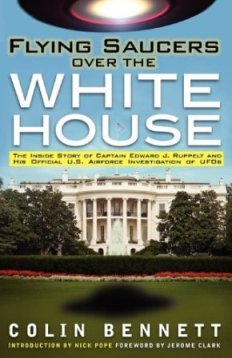Flying Saucers over the
White House

By
Colin Bennett
Subtitled "The Inside Story of Captain Edward
J. Ruppelt and his Official U.S. Airborne Investigation of UFOs"
(Previously titled "An American Demonology",
Headpress, Manchester 2005)
Cosimo
Books, 2010
ISBN 978-1-61640-454-3
$16.95/£12.99
I received this book for review along with a re-release of Edward
J. Ruppelt's 1956 book "The Report on Unidentified Flying Objects". As I
read the "Flying Saucers over the White House", the reason for that combination
made more sense. This book is part biography, part commentary on the life
and work of Captain Ruppelt. But, more than that, it's also a thesis on
officialdom's complex relationship with the UFO.
Ruppelt was the head of Project Blue Book, a
role which emerged from his interest in UFOs when stationed at ATIC,
Wright-Patterson Air Force Base. The previous investigation into flying saucers
taking place there was a tired and cynical investigation under the rather apt
name Grudge. Ruppelt brought a fresh set of eyes to the mystery, at a time
when the public and military's interest in the question of UFOS was peaking.
Thankfully, he lacked the dismissive attitude and 'low mental level' of his
predecessors, and appeared open to the potential for an extra-terrestrial
explanation. But his feet were also firmly placed on the ground as he
conducted his work - often with little funding and less manpower at his
disposal. Eventually, however, his tenacity went unrewarded, as the top
brass in the Pentagon decided to place the UFO beyond the reach of reasonable
enquiry through Kafka-style manoeuvring, superbly exposed in this sharply
intellectual book.
Bennett is one of those rare authors, like
Stanton Friedman, who can convincingly shed a cynical eye across the
military-industrial complex. Of course, in any debate, there are two sides
to the story. Each side spins the facts, and this book is a commentary with a
particular viewpoint, like any other. But Bennett is not just projecting
opinion, like so many do on the irate Internet of today. His work is
contextual, historical, analytical. He seeks to place the UFO, and the Air
Force's struggle to come to terms with it, into the social milieu of the times,
and the changing face of modernism.
"The UFO phenomenon
is about people and societies as much as it is about whatever it is in itself".
(p45)
This is true, and the human reaction to UFOs
is vital to its understanding, as well as the changing face of the phenomenon
itself over the decades/centuries. Sometimes Bennett waxes lyrical too
much, turning the office politics of the Air Force into a Shakespearian drama.
But his writing is well versed and educated, and defies easy dismissal by those
who would be offended by his openness to another reality. Radar
reports, trained observers, scrambled aircraft all attest to something real
manifesting itself in the skies of the United States in the early 1950s.
The phenomena in question defied rational explanation, although many were
brought to bear. In the end, the chaotic display exhibited by an inept and
intellectually-challenged Air Force in the face of the perceived UFO threat had
to be culled, and Ruppelt was a victim of officialdom's whitewash. The
days of enlisted men being able to speak their minds were fast coming to an end.
There is more to it than officially kicking
the subject into the long grass, though. Attention is also given in the
book to how normally rational military men reacted in irrational ways when
confronted with flying saucers. There were occasions, described by Ruppelt
himself, where evidence about UFOs, in the forms of reports and data, was
purposely destroyed by base commanders and intelligence officers. Such
intervention would under normal circumstance be actionable, yet seemed oddly
acceptable (an Escher-Penrose State). It was like the UFO did not fit into
the great scheme of things in the military's materialistic and highly controlled
mindset. It needs to be expunged. In this way, one wonders whether
the abundance of UFO evidence handed over to various ministries and departments
down the years was simply shredded by discomforted officials. Does the
debris of the Roswell crash sit deep inside some toxic landfill, I wonder?
Better buried and out of the way, perhaps.
Bennett also argues that there was a lack of
courage among the 1950s military to declare that the UFO represented something
tangible, but unknown. In a masterful critique of the press conference
held after the post-Washington sightings in the summer of 1952, he demonstrates
how General Samford and his colleagues nullified the phenomenon in front of the
nation's press and his own officers. A message was sent, the case was
closed, and a direction of travel was forged by America's military that has
survived right up to the current day: inexplicable encounters simply require
more data before they become explicable, observers are unqualified to comment
upon what they've witnessed, no matter who they are, and there is NO defence
threat. Nothing to see here.
This is a thought-provoking and superbly
written book. Its new title is a big improvement, and its historical
relevance remains strong. One wonders how our modern generals would deal
with the UFO phenomenon should the flying saucers once again persistently buzz
the skies over the nation's capital. Sixty years on, and I imagine the
reaction would be much the same.

 You can order your copy through Amazon.com here:
You can order your copy through Amazon.com here:
Flying Saucers over the White House
 If you live in the UK, you can obtain your copy through Amazon.co.uk here:
If you live in the UK, you can obtain your copy through Amazon.co.uk here:
Flying Saucers over the White House
Book review by Andy
Lloyd, 2nd August 2011
Books for review can be sent to Andy
Lloyd at the author/publisher's own risk.
andy-lloyd@hotmail.com

Book Review Listings by
Author and Title
Book Review
Listings by Subject



